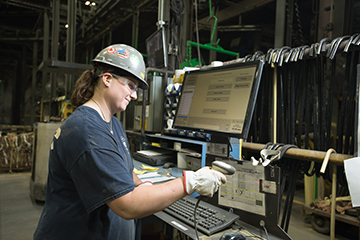
Do You Have Sufficient Control Over Your Inventory Accuracy?
February 10, 2017
Inventory accuracy can mean the difference between a calm day at work and chaos.
How many times have you needed to dedicate busy team members to fixing a problem that could have been prevented if you had a required item in stock?
Address these recurring problems at the source by implementing a strategy that ensures accurate inventory. Rather than addressing issues on a case-by-case basis, you need to make a systemic change.
Having control over your metal parts inventory accuracy is important because you must know what items you have on hand to meet customer requirements and make changes based on their demand.
In business, nobody wants surprises, but you should be prepared in case they occur. If a customer suddenly increases an order size, it’s critical that your inventory count is accurate.
Use Cycle Counting To Make Systemic Changes
Although cycle counting is a means of measuring metal parts inventory accuracy, and not a means of controlling it, you can’t have control without measurement. Cycle counting is necessary for inventory control because it shows you where corrections or changes need to be made.
To begin with, you should classify your inventory items into three categories:
- A items are your highest-moving items
- B items are your next highest-moving items
- C items have the lowest usage and may move sporadically throughout the year
Through cycle counting, you may check A items once per month, B items once per quarter and C items annually.
As you count each item, you shouldn’t be trying to prove that your inventory is accurate. You should be looking for potential issues. Once you find a problem, you may identify correlations with other inventory problems. For example, you might find that a certain part type is consistently noted incorrectly in your inventory.
You should also check that the products are in the right locations. Remember not to skip empty bin locations. You should always verify that the bins are indeed empty.
Cycle counting requires you to check inventory across your whole company, so it’s inherently objective. You test the system itself, and not just areas you think are the most important.
Locating unexpected gaps helps you decide what systemic changes to make so that moving forward your inventory is more accurate.
If you discover an issue while counting or simply by happenstance, you must take corrective measures right away. Inventory problems can’t be put off for another day – they’re an urgent matter that requires resolution.
Expert Tips To Fine-Tune Your Inventory Accuracy
Once you start making changes based on your cycle counting findings, you’ll be off to a good start. Next, you should follow these expert tips to further improve your inventory accuracy:
- Record inventory movement faithfully and accurately. Every time inventory moves or changes, you must record the transaction.
- Specify and record locations for all inventory parts. Sound warehouse management is critical – you should always know where your inventory is.
- On an annual basis, perform a physical inventory during a shutdown period while transactions aren’t taking place. You’ll need to plan and execute carefully to ensure an accurate count.
- If you use material utilization software, such as nesting software, you must integrate it with your ERP system. You need an accurate picture of the material that has been consumed. Integrating these two software programs keeps variances to a minimum.
Above all, be disciplined. Inventory tools are helpful, but you need strong organizational and process discipline to ensure inventory accuracy.
Partner With A Fabrication Specialist That Maintains Accurate Inventory
A reliable fabrication partner should be able to tell you whether it has the metal parts you need in stock.
Your partner should also be able to ship your required parts on short notice, if necessary. However, it won’t know for certain whether it needs to manufacture more parts to maintain its inventory unless it keeps an accurate inventory count.
Consider the following example: Your records may indicate that you have a certain item. After beginning production on a machine, you realize you’re missing the necessary part.
If your metal manufacturer has maintained an accurate inventory, it should have the part in stock, mitigating a problem that could have seriously delayed your production.
That’s why it’s critical the partners you work with are committed to metal parts inventory accuracy. If you encounter an inventory problem in-house, your partner should be a dependable backup.
Once you gain control over your inventory accuracy, you’ll notice a major difference in how your OEM operates. You’ll be able to plan for shifting demand and your customers will appreciate your reliability. Plus, you’ll be prepared to beat your competition to major deals when you have the items you need in stock, allowing for greater revenue potential.